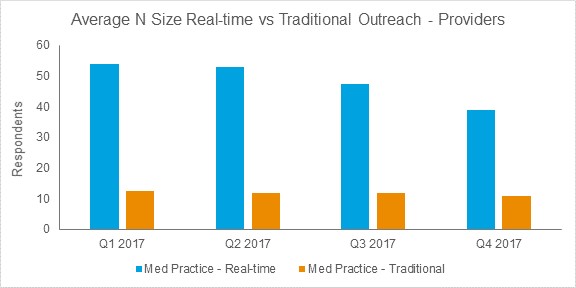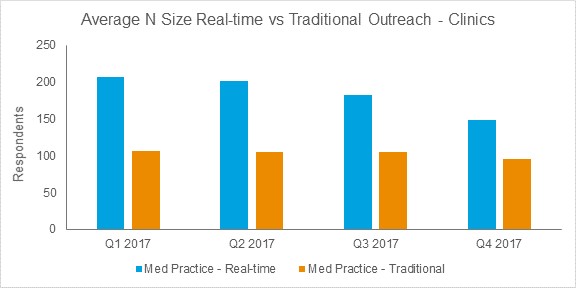Imagine if our ability to collect feedback and engage with patients kept pace with the innovations occurring in other industries. How could healthcare organizations benefit from the elegance and efficiency that technology and retail giants have brought to consumers?
What if, for example, patient survey responses came back within hours of a care incident, instead of weeks? Organizations would have newfound opportunities for remediation, if something went wrong; they’d be able to reach out to the aggrieved patient instantly and take steps to make it right.
Or suppose feedback platforms reached many more patients than they do under current industry norms. Wouldn’t that help lend credibility to the feedback collected? Wouldn’t organizations have an easier time coaching employees and clinicians on their behaviors, and implementing change organization-wide?
What if patient feedback enjoyed the network effects and targeted intelligence of social media? Your organization could sharpen follow-up to patient responses and build engaged communities of patients from the ground up. And your patients, in turn, would be more than passive consumers of care; they’d be contributive investors in your organization’s success.
These refinements can move an organization beyond a narrow, episodic conception of care. They’re the foundation for a holistic understanding of the patient’s journey from start to finish.
If they sound far-off and fanciful, they’re not. Forward-thinking organizations have already started to deploy them. To advance to this next level of gathering and understanding patient feedback, organizations should first use patient-friendly and cutting-edge technological platforms to augment their collection efforts, and second, expand the scope of their understanding of the patient experience.
Augment your feedback
As a matter of public policy, Consumer Assessment of Healthcare Providers and Systems (CAHPS) surveys have been a success. Since their inception in 2006, the Centers for Medicare and Medicaid–mandated surveys have brought public accountability to the healthcare industry, and have sharpened the focus on patient satisfaction.
But CAHPS surveys have limitations. Hospitals that rely on them exclusively could be missing important opportunities to engage with patients and change their organizations for the better. Here are three important benefits to taking steps beyond CAHPS:
- Engage patients with a streamlined feedback process
Your patients want to tell you about their care experiences. If your organization can make that process simple, they’ll offer their feedback with renewed enthusiasm.
NRC Health research has found that 73% of patients prefer to give their feedback within a few days of the episode of care—with 29% saying they’d report back in a few minutes, if they could. Instantaneous, digital-friendly outreach unearths more detail about episodes of care, and drives up response rates among the patients who receive it.
That’s especially true for younger generations. Among a cohort of 10 NRC Health provider partners, the switch from traditional CAHPS modalities to a real-time feedback platform brought about a 22% increase in response rates from millennials. Research has also shown that providers that use real-time outreach see approximately 3.5 to 4.5 times the number of responses per quarter seen by those that use traditional methods of outreach.
- Rally clinicians around results
Gaining more responses, in turn, garners confidence among clinical staff. Trained to evaluate statistical evidence, your clinicians have high standards for the validity of feedback data, and justifiably so.
When your feedback system hears back from patients immediately and in large numbers, clinicians can be assured of the data’s legitimacy. This makes it easier for your organization to make a compelling case for change at the front lines of service.
On average, clinics that use real-time outreach see approximately 1.5 to 2 times the number of responses per quarter seen by those that use traditional outreach.
- Instantly intervene when complaints arise
When a patient experiences a deficiency in service, the window of opportunity to regain their trust is very short. By eliminating lag time in feedback responses, you empower your organization to seize that opportunity by responding rapidly to patient concerns.
The end result: patients will stay with you, and will happily continue to bring their $1.4 million of average lifetime healthcare spending to your doors.
The long-view perspective
Another limitation of CAHPS surveys is their episodic focus. They’re bound to a narrow time frame and confined to specific instances of treatment. While this is both important and helpful, most hospital leaders recognize that a patient’s relationship with an institution is more than just the sum of their care experiences.
To sustain patient loyalty, it’s essential to shift from an episodic perspective to a holistic, longitudinal perspective of the patient’s care journey. This means striving to understand every interaction a patient has with your brand—whether that happens before they seek treatment, in an exam room, or well after they leave the building.
The building blocks of relationships
Adopting this more expansive view of the patient experience has been a challenge for many organizations. Brand interactions that happen outside the hospital walls have proven difficult to track, quantify, and measure. Resolving this difficulty starts with identifying these interactions and studying the dynamics behind them.
For instance, before a care need arises, how do people in your community become aware of your organization? And once they’re aware, how do they feel about it? Do they engage with your brand, whether on social media or at local events? Is your organization meeting patients’ expectations and making care accessible to them?
Answering these questions will teach you what your community expects from a healthcare organization. It will also engender a holistic perspective that will inform the strategies you can use to earn patient loyalty.
Patients, after all, are continuously evaluating their needs, searching for providers, and assessing how those providers perform. The better you understand that process—and how to engage patients while they undertake it—the better off your organization will be.
Putting that understanding into practice requires a quantitative grasp of the constituent components of loyalty. This understanding will help you form benchmarks for cultivating patient relationships. From there, you can improve how you position yourself with patients, and illuminate how your organization stands in relation to its competitors.
This all-encompassing vision, grounded in solid market research, is critical if you want your institution to weather the shocks of healthcare consumerism. It’s important to proactively nurture this perspective at your organization and seek out the metrics that support it. Once you can measure patient loyalty, you can manage it.
What measurement enables
Implementing modern patient-feedback platforms and measuring patient loyalty in a community are both demanding tasks. But once they’re accomplished, the resulting new streams of data offer unprecedented clarity and depth of consumer insight. Collectively, these measurements empower more intelligent approaches to patient relationships and induce genuine institutional improvements.
Broader—and smarter—engagement
All of this sets a virtuous cycle in motion. Transitioning from traditional surveys will sharpen your feedback. That will make you able to hone your surveys down to the most impactful questions, and determine their most effective timing and modality. Whenever you uncover intriguing—or troubling—results, you’ll also be able to perform targeted, intelligent follow-up.
Richer feedback data, in turn, can help expand your relationships with patients. Feedback collected in real time, for instance, will quickly identify your brand’s strongest promoters. Prompt engagement on social media will bolster the impact that these fans have on your online presence. Alternatively, you’ll also spot detractors sooner, and you’ll be able to start a dialogue with them to better understand where the care interaction went wrong. They’ll appreciate the earnest engagement, and your reputation with your community will flourish.
Genuine change
Even more importantly than enabling better feedback operations, moving beyond CAHPS will also generate improvements in care.
Reliable feedback will lend survey data more visibility, legibility, and legitimacy in the eyes of your staff. Administrators will have figures they can grasp and base their decisions on, clinicians will have benchmarks to use to assess their performance and motivate them to improve, and the organization as a whole will benefit from a clearer conception of how it stands in the community.
It takes vision and diligence to advance beyond the CAHPS status quo. But if you can embrace the new paradigms of patient experience—and master the necessary tools to effect the transition—you can achieve remarkable things for your organization.